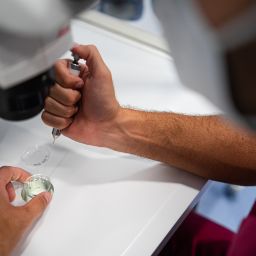
Many people dream of starting a family, but sometimes the journey to motherhood or fatherhood is not as straightforward as they imagined. Receiving an infertility diagnosis, especially in complex cases, can generate doubts and concerns. It is important to remember that you are not alone, and that today reproductive science and medicine offer real tools to help bring you closer to your dream of becoming a parent.
Assisted reproduction combines cutting-edge science with a deeply human approach. Every decision made in the laboratory has a purpose: to increase the chances of success while caring for your emotional well-being. Behind each technique and every step, our goal remains the same: to create new opportunities for life.
The Importance of Personalizing Treatment
There are no universal recipes. Each person and each couple is different, which is why we begin with a comprehensive diagnosis:
• Medical history
• Hormonal analysis
• Evaluation of eggs and sperm
• Genetic testing if necessary
With all this information, we design a plan tailored to your needs. It is not only about applying techniques, but about creating the strategy with the highest chances of success (Gardner et al., 2018).
When Eggs or Sperm Need a Little Extra Help
Sometimes, the difficulty lies in the quality of the gametes. However, there are techniques that can help:
- ICSI: direct insertion of a sperm cell into the egg.
- Advanced sperm selection (IMSI, PICSI, microfluidics): selecting sperm cells with the highest potential.
- Specialized incubators: replicating conditions very similar to those inside the human body (Gardner et al., 2018; WHO, 2023).
These strategies give each gamete the best chance to become a healthy embryo.
Caring for Embryos: Attention to Every Detail
After fertilization, embryos require delicate care:
- Time-lapse: monitoring without removing them from the incubator.
- Artificial intelligence: identifying the embryos with the highest chances of implantation.
- Specialized culture media: nourishing embryos at each stage (Meseguer et al., 2012; Gardner et al., 2018).
All these tools support more informed decisions and increase the likelihood of success.
Vitrification: Adding Opportunities
When only a few eggs are produced, vitrification allows them to be frozen or embryos to be accumulated for later transfer.
This increases the chances of pregnancy and provides more options, especially in complex situations (Rienzi et al., 2019).
Looking a Little Further: Tests That Can Help
Some additional tests can make a difference:
- PGT-A: selection of chromosomally normal embryos.
- Endometrial receptivity test (ERA): identifying the best moment for transfer.
- Endometrial microbiome study: analyzing how uterine bacteria influence implantation (Simon & Bellver, 2018).
These tests are not always necessary, but in certain cases, they may open new opportunities.
Let’s Not Forget the Most Important Part: Human Support
Assisted reproduction treatments are an emotional journey. It is normal to feel anxious or frustrated.
Having a team that includes specialized psychologists, in addition to doctors and embryologists, can make all the difference. Emotional support helps you face each step with greater peace of mind and keeps hope alive (Gardner et al., 2018).
Conclusion: Hope and Science Hand in Hand
Complex infertility cases can be challenging, but they are not insurmountable. The combination of personalized strategies, advanced technology, and human support creates real pathways to motherhood and fatherhood.
Every decision made in the laboratory is taken with you in mind—your well-being and your dream. Because in the end, every step we take has one single purpose: to give you the best opportunity to build the family you long for.
References
- Gardner, D. K., Weissman, A., Howles, C. M., & Shoham, Z. (2018). Textbook of Assisted Reproductive Techniques. CRC Press.
- Meseguer, M., Rubio, I., Cruz, M., Basile, N., Marcos, J., & Requena, A. (2012). Embryo incubation and selection in a time-lapse monitoring system improves pregnancy outcome compared with a standard incubator: a retrospective cohort study. Fertility and Sterility, 98(6), 1481–1489.
- Rienzi, L., Gracia, C., Maggiulli, R., LaBarbera, A. R., Kaser, D. J., Ubaldi, F. M., & Racowsky, C. (2019). Oocyte, embryo and blastocyst cryopreservation in ART: systematic review and meta-analysis comparing slow-freezing versus vitrification. Human Reproduction Update, 23(2), 139–155.
- Simon, C., & Bellver, J. (2018). Reproductive microbiome: the role of the endometrial microbiota in human reproduction. Fertility and Sterility, 110(3), 337–343.
- World Health Organization. (2023). Infertility. Available at: https://www.who.int/news-room/fact-sheets/detail/infertility






